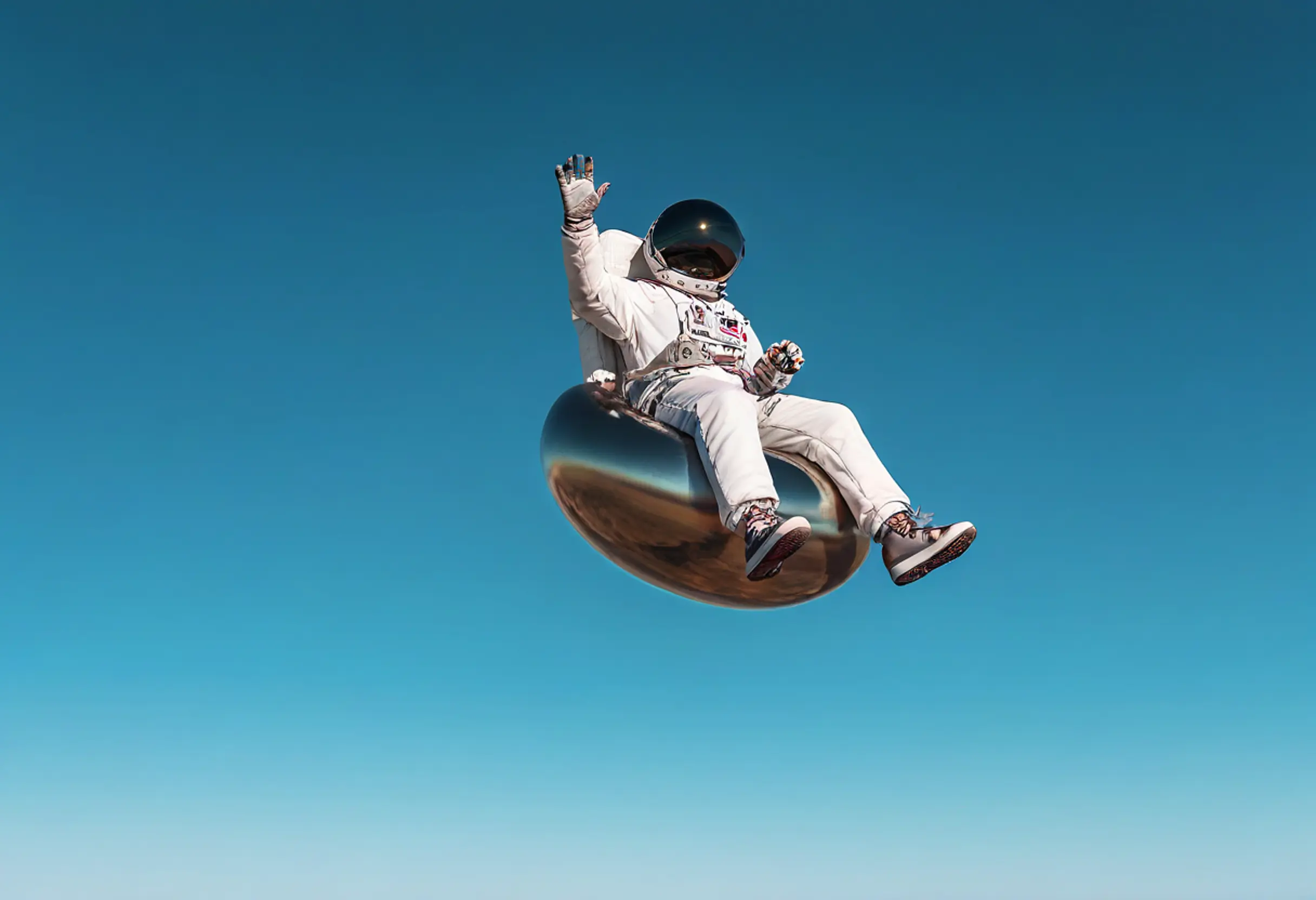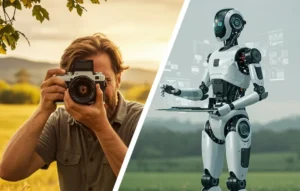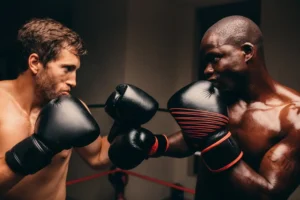Artificial Intelligence is happening all around us. The applications that incorporate AI are expanding, and it has the potential to revolutionize our lives, from healthcare to finance and, of course, photography.
AI brings the capability to optimize processes and improve outcomes. As we continue to develop and improve AI, we expect to see many more breakthroughs in the years to come.
Photography uses artificial intelligence in ways you may not be aware of. Advanced autofocus systems in modern cameras depend on AI. Photo editing tools employ AI to remove noise and enhance the detail and sharpness of images. Specialized websites apply text prompts to create AI-generated photos. So we’ll all be out of work. Just kidding.

In this article, we’ll help you stop worrying and learn to love AI in photography. Without getting too deep into the technology behind AI, we’ll explain how it works and how it evolved.
In addition, we’ll explore its applications in digital cameras and the post production workflow. And we’ll speculate on what the future may bring as new developments in AI photography emerge.
Contents
What is AI?
Artificial Intelligence is a method for predicting and analyzing data. It simulates human intelligence on an electronic computer. The program learns and retains the information as it develops. It can be implemented on almost any computer.
AI produces good outcomes because it is familiar with its environment. It can be used to optimize processes in a wide variety of fields, including healthcare, transportation, and finance. It becomes particularly apparent in areas in which optimization involves human elements. Examples include the use of AI in healthcare to predict health risks and assist in diagnosis. In transportation, AI can optimize traffic flow and reduce congestion. And in finance, AI can assist in fraud detection and risk management.
We’ll get to photography in a moment.
The History of AI
Artificial Intelligence originated in the 1950s when computer scientists first began experimenting with the idea of simulating human intelligence. Since then, AI has come a long way. Fast-forward to 2013. Deepmind developed an AI program to play the video game Breakout. It played game after game until it figured out the best strategy for winning. This was a major breakthrough in the field of AI, and it paved the way for further innovation.
The Future of AI in Photography
Today, artificial intelligence technology impacts photography in exciting ways, and it revolutionizes the way we photograph and process images.
Imagine a program that could learn from millions of photographs and then be able to identify objects, people, and even emotions in a photo. AI could also be used to create personalized content for individuals in real time.
The future of AI is bright, and we can anticipate many more breakthroughs in the years to come.
Facial Recognition in Digital Photography
Digital photography technology advanced significantly in recent years. One of these advancements is in facial recognition. This is a biometric technology that allows cameras to recognize human faces. Technology companies applied this feature to secure their digital devices. The software learns the user’s facial features, stores them, and allows the user to unlock the device by recognizing his or her face.

Digital cameras incorporate facial recognition technology into the autofocus system. The early point-and-shoot camera typically photographed people. The camera would analyze the scene, identify faces within the image and prioritize the focus on the faces.
With AI recognition, there is no longer a need for direct focus on a subject’s face. This simple change has resulted in a huge step in efficiency. Most modern digital cameras come equipped with facial recognition technology, ensuring that the camera sets focus and exposure quickly and accurately.
Eye Detection and Subject Recognition
A further advancement in digital photography is eye detection, a technology that enhances portrait photography by focusing the camera on the subject’s eyes. Eye detection made it easier for photographers to advance from good portraits to stunning portraits.
Along with eye detection, animal detection was developed to detect and track animals, advancing the art of wildlife photography. Capturing images of animals can be challenging. As technology advances, look for even more exciting developments in digital photography.

Environment Recognition
Identifying the environment is a further development of AI images. This is used in the camera settings of smartphones, such as Apple’s Portrait mode.
The feature works by detecting the main content in the foreground and then creating a simulated shallow depth of field, or bokeh. This effect brings the subject into sharp focus while blurring the background. As a result, the primary object of the photograph becomes more prominent, drawing the viewer’s attention to it.
Environment, or scene recognition, solutions found uses beyond photography, including entertainment apps, medical tools, and security systems.

Further Development of AI Software
As artificial intelligence continues to develop, we expect to see more advanced applications for digital photography. AI can change the way photographers capture and edit images, making post-processing less time-consuming and allowing them to focus more on capturing shots.
One of the most significant advantages of AI technology in cameras is the ability to automate certain features, which saves photographers time and energy.
For example, AI can automatically adjust camera settings based on the subject and lighting conditions, which helps photographers get better shots without spending so much time manually adjusting the settings. AI can also be used to remove unwanted objects or people from photos, saving the hassle of editing them manually.
In addition to editing and post-processing, AI technology can also change the way photographers approach composition and framing.

For example, AI can help photographers find the best composition and framing for their shots based on the scene and the environment. So this helps them get better photos, even if they are shooting in difficult or unfamiliar conditions.
However, some photographers may be concerned that AI technology will take away their creative control.

Remember that AI is simply a tool that can be used to enhance a photographer’s creative vision. While AI can certainly make some tasks easier and more efficient, it cannot replace the artistic eye and creative vision of a skilled photographer.
AI Assisted Photo Editing Software
Artificial intelligence technology revolutionized the world of photography, making it possible to create stunning images and edit them with ease. By using AI tools, photographers can save time and focus on their creativity without worrying about the technical aspects of editing.
AI photo editing has become accessible and affordable for everyone. With just a few clicks, you can remove the background of an image, adjust colors, and even enhance and retouch portraits.
Some of the exciting AI photography tools include Adobe Firefly, Luminar Neo, and Topaz AI Gigapixel.
- Firefly by Adobe employs machine learning algorithms to create or edit artwork. It generates various artistic styles and is intended to simplify the creation and editing of artwork.
- Luminar Neo from Skylum is a raw photo processing program. It can be used as a plugin for Photoshop or Apple Photos or as a stand-alone editing solution.
- AI Gigapixel is a Topaz Labs application for upscaling images. Some reviews call it superior to Lightroom’s Super Resolution and ON1’s Resize AI.
We published an article on the best software for photographers that details more programs.
These platforms are intended for professional photographers and designers and require a subscription or one-time payment; however, they can help you take your photography to the next level and achieve amazing results.
The pictures below show a raw file on the left and the same file enhanced with higher resolution on the right.

AI Generated Imagery and How It Works
AI-generated art produces impressive visual creations; however, it may not possess the same emotional depth or intention as human-created art. Critics contend that AI-generated art lacks originality and creativity, two vital elements of outstanding images.
Using text prompts, artificial intelligence generates images that mimic real photographs. AI does this by collecting data, training the AI model, and then generating the AI image.
The initial step to generate AI images is to collect and store a large gallery of images, a dataset. From this, AI generators learn the features, patterns, and styles of the images. An AI system with a large and diverse dataset can create a wide variety of images.
Then, the AI system is trained using an algorithm called a neural network. This is a computational model that mimics the neural networks in the human brain. The neural network learns to identify and recognize the patterns, features, and styles of an image.
With training completed, the AI system can generate new images through sampling. The system combines elements from the dataset to generate a new AI image. This new image may look like an actual photograph, or it may be pure fantasy.

A Quick Look at Some AI Image Generators
Artificial Intelligence will not take over all human tasks. It is merely a tool that we can use to journey in new creative directions.
A few of these new tools include NightCafe, DALL-E 2, Midjourney, and VistaCreate. These are paid platforms; however, you may be able to try them at no charge. Or you might search for free websites.
- NightCafe was created for designers and artists. It features a community of regular users and poses art challenges. It offers access to multiple AI algorithms.
- DALL-E 2 is a popular platform developed by OpenAI. Users generate images of stunning realism by entering text prompts.
- Midjourney creates images and art in a variety of styles. By entering text prompts, users generate impressive images and graphics.
- VistaCreate allows users to create professional-quality visuals effortlessly. It offers a wide range of customizable templates and AI-powered tools for generating unique images, making it ideal for social media posts, ads, and creative projects.
I generated the AI image below with VistaCreate AI Image Generator, using this prompt: “A single astronaut in a sleek white spacesuit with reflective black visor, sitting casually on a shiny, metallic, bean-shaped floating object, waving with one hand. The background is a clear, vibrant blue sky with no clouds. The scene has a surreal, futuristic vibe, with soft natural sunlight and sharp details.“

The Ethics of AI-Generated Images
The winner of the 2023 Sony World Photography Awards confessed that his winning submission was not an actual photograph but an AI-generated image, shown below.
Boris Eldagsen, a German artist, won the top prize in the creative/open category for Pseudomnesia: The Electrician. He told media outlets that he entered the image as a test for the prestigious competition and that he hoped to start a dialogue about the future of photography.

That dialogue is underway. Advocates of AI art point out its ability to streamline and automate complex processes, such as editing, key-wording, and file storage. AI also brings new creative opportunities, generating unique compositions or creating images impossible to capture with traditional methods of photography. For example, using prompts to place the head of a tiger on the body of a bluejay in an AI image.
Critics of artificial intelligence point out the photographer’s diminished role in the creative process, with algorithms making the final decisions about an image. And if those algorithms hold a bias toward certain styles, images created or edited with AI would tend to look the same.
There is also a legal angle. If a copyrighted photo is part of a dataset and a portion of that photo, say the shape of a nose, is used in an AI-generated image, what are the copyright implications? Is that considered fair use? And can you opt out of inclusion in a dataset?
The legal aspects, especially concerning copyright law, make up a gray area not yet settled.

In Closing
Artificial Intelligence is transforming the art and business of photography in ways that were difficult to imagine only a few years ago. Yesterday’s industry standard, for example, face detection, launches a new feature, eye detection, today and another innovation tomorrow.
Cameras adjust settings automatically according to the type of scene detected. In post-processing, AI-enabled software can automatically enhance color, detail, and other factors. As science evolves, we expect to see even more innovations in photography.
From editing software to image recognition, AI is rapidly revamping how we approach and create images. As a result, it’s easier to capture stunning photographs with little effort or transform a mediocre picture into a work of art.
Producing original images with just a camera and your artistic vision and skills is a special experience. Also, artificial intelligence used to enhance photographs or create a unique style is an equally singular experience for the artist.
I hope you’ve enjoyed this introduction to the uses of AI in photography. If you have any questions or comments, please submit them in the space below.










I very much appreciated your review. For all the concerns about the end of photography, I think it’s a classic case of crying wolf. Let’s face it, photography has already greatly changed with the introduction of smart phones. One way to look at this is to ask the question: Are smart phone image users really photographers in the traditional sense, or are they a new phenomenon? I wonder if you have considered the meshing of AR and AI photography.
We address AI, augmented reality, and virtual reality in the PhotoKarma trend report here: https://greatbigphotographyworld.com/trends/
I think the new phenomenon you refer to is that everyone now has a camera. Whether or not they can produce quality photos – photographs that someone would frame and hang on the wall or use in a blog post or magazine is another matter.